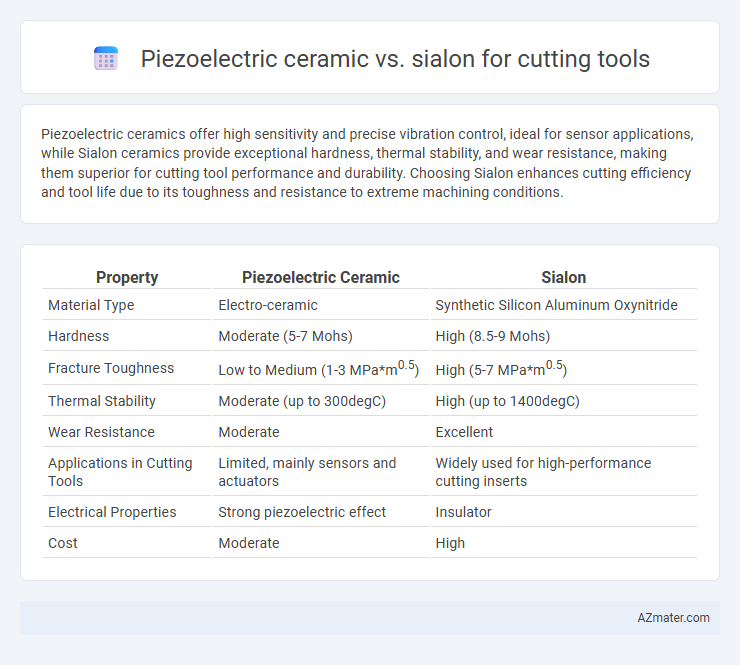Piezoelectric ceramics offer high sensitivity and precise vibration control, ideal for sensor applications, while Sialon ceramics provide exceptional hardness, thermal stability, and wear resistance, making them superior for cutting tool performance and durability. Choosing Sialon enhances cutting efficiency and tool life due to its toughness and resistance to extreme machining conditions.
Table of Comparison
| Property | Piezoelectric Ceramic | Sialon |
|---|---|---|
| Material Type | Electro-ceramic | Synthetic Silicon Aluminum Oxynitride |
| Hardness | Moderate (5-7 Mohs) | High (8.5-9 Mohs) |
| Fracture Toughness | Low to Medium (1-3 MPa*m0.5) | High (5-7 MPa*m0.5) |
| Thermal Stability | Moderate (up to 300degC) | High (up to 1400degC) |
| Wear Resistance | Moderate | Excellent |
| Applications in Cutting Tools | Limited, mainly sensors and actuators | Widely used for high-performance cutting inserts |
| Electrical Properties | Strong piezoelectric effect | Insulator |
| Cost | Moderate | High |
Introduction to Advanced Cutting Tool Materials
Piezoelectric ceramics and Sialon represent two advanced cutting tool materials with distinct properties tailored for high-performance machining. Piezoelectric ceramics offer precise vibration control and enhanced tool stability, improving surface finish and dimensional accuracy in ultra-precision cutting. Sialon, a silicon nitride-based ceramic, excels in wear resistance, thermal shock resistance, and toughness, making it ideal for high-speed and interrupted cutting operations.
Overview of Piezoelectric Ceramics in Machining
Piezoelectric ceramics, such as lead zirconate titanate (PZT), are widely used in machining for their ability to convert mechanical stress into electrical signals, enabling precise vibration control and real-time condition monitoring in cutting tools. These ceramics enhance tool performance by improving surface finish, reducing tool wear, and enabling high-frequency ultrasonics machining, which is essential for processing hard and brittle materials. Compared to Sialon ceramics, which offer superior toughness and thermal stability, piezoelectric ceramics provide distinct advantages in smart tool applications and adaptive control systems within advanced manufacturing processes.
Sialon Ceramics: Composition and Applications
Sialon ceramics, composed primarily of silicon, aluminum, oxygen, and nitrogen, offer superior hardness, thermal stability, and wear resistance compared to piezoelectric ceramics, making them ideal for cutting tool applications. Their excellent toughness and resistance to oxidation enable high-performance machining in demanding industrial environments, particularly in metal cutting and milling operations. These properties contribute to longer tool life, enhanced precision, and increased efficiency in high-speed cutting processes.
Mechanical Properties: Strength and Hardness Comparison
Piezoelectric ceramics typically exhibit high hardness but moderate strength, making them suitable for applications requiring precision but limited impact resistance. Sialon ceramics, composed of silicon, aluminum, oxygen, and nitrogen, demonstrate superior mechanical strength and hardness, offering enhanced toughness and wear resistance crucial for cutting tools subjected to heavy machining. The comparative analysis reveals that Sialon's combination of high fracture toughness and hardness significantly outperforms piezoelectric ceramics, resulting in longer tool life and better performance under mechanical stress.
Wear Resistance: Piezoelectric Ceramic vs Sialon
Sialon cutting tools demonstrate superior wear resistance compared to piezoelectric ceramics due to their enhanced toughness and thermal stability under high-stress machining conditions. The dense microstructure and chemical stability of Sialon minimize abrasive and adhesive wear, extending tool life in metal cutting applications. Piezoelectric ceramics, while useful for sensing applications, generally exhibit lower wear resistance and mechanical strength, making them less suitable for demanding cutting tool environments.
Thermal Stability and Cutting Performance
Piezoelectric ceramic exhibits moderate thermal stability but struggles with heat dissipation during high-speed cutting, limiting its cutting performance in intensive machining. Sialon, a silicon-aluminum-oxynitride ceramic, offers superior thermal stability with a high melting point exceeding 1750degC and excellent thermal shock resistance, ensuring consistent cutting performance under extreme temperatures. Its enhanced wear resistance and toughness make Sialon an ideal cutting tool material for maintaining precision and tool life in demanding industrial applications.
Chemical Stability and Oxidation Resistance
Piezoelectric ceramics exhibit moderate chemical stability but suffer from limited oxidation resistance at high temperatures, restricting their use in harsh cutting tool environments. Sialon, an advanced ceramic composed of silicon, aluminum, oxygen, and nitrogen, offers superior chemical stability and outstanding oxidation resistance, maintaining structural integrity under extreme thermal and oxidative conditions. These properties make Sialon highly suitable for cutting tools requiring durability and longevity in aggressive machining applications.
Machinability and Tool Life Analysis
Piezoelectric ceramics exhibit higher brittleness and lower machinability compared to Sialon, which offers enhanced toughness and machinability suitable for complex cutting tool geometries. Sialon's superior thermal conductivity and resistance to wear result in extended tool life under high-speed and dry machining conditions, outperforming piezoelectric ceramics prone to micro-cracking and chipping. Tool life analysis indicates Sialon cutting tools maintain sharper edges and dimensional stability over prolonged use, reducing downtime and improving machining efficiency.
Cost Efficiency and Industrial Applications
Piezoelectric ceramic cutting tools offer high precision and rapid response times, making them ideal for industries requiring fine, detailed machining, but their cost is generally higher due to complex manufacturing processes and material properties. Sialon cutting tools provide superior toughness, wear resistance, and thermal stability, resulting in longer tool life and reduced replacement costs in heavy-duty industrial applications like aerospace and automotive manufacturing. The overall cost efficiency of Sialon tools is enhanced by lower downtime and maintenance expenses, whereas piezoelectric ceramics excel in cost-effectiveness for specialized, small-scale, or high-precision cutting tasks.
Future Trends in Cutting Tool Materials
Piezoelectric ceramics offer high sensitivity and rapid response for precision cutting tool applications, while Sialon ceramics provide superior toughness and thermal stability for high-speed machining. Future trends in cutting tool materials emphasize hybrid composites combining piezoelectric properties with the mechanical robustness of Sialon to enhance tool life and reduce wear. Advanced nanostructured Sialon and integrated piezoelectric sensor systems are expected to drive innovations in smart cutting tools for Industry 4.0 manufacturing environments.

Infographic: Piezoelectric ceramic vs Sialon for Cutting tool
 azmater.com
azmater.com